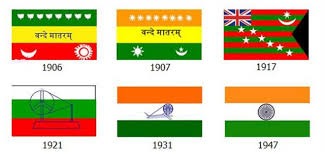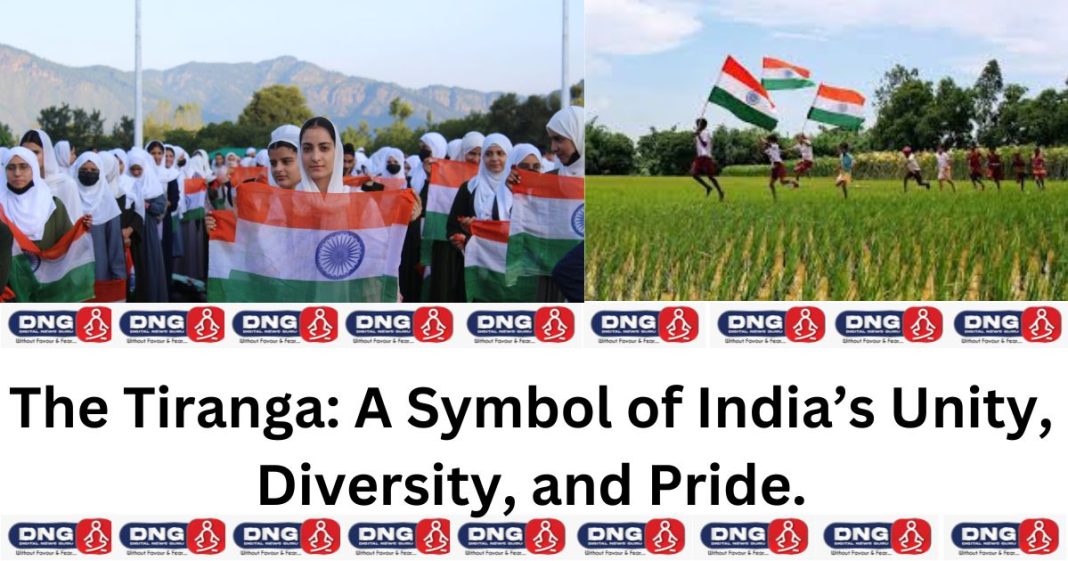DIGITAL NEWS GURU NATONAL DESK :-
The Tiranga: A Symbol of India’s Unity, Diversity, and Pride.

The Tiranga, or the tricolour, is more than just a flag for India; it is a powerful symbol of the nation’s unity, diversity, and rich cultural heritage. The Indian national flag, known as the Tiranga due to its three distinct colors, represents the collective identity and aspirations of over a billion people.
Since its adoption on July 22, 1947, just weeks before India gained independence from British rule, the Tiranga has been a constant reminder of the country’s journey from colonial subjugation to sovereignty, and its ongoing quest for justice, equality, and prosperity.
Historical Significance of the Tiranga:
The journey to adopting the Tiranga as the national flag was fraught with debates and discussions, reflecting the complex political and social landscape of pre-independent India. The first instance of a tricolour flag being used as a symbol of Indian identity dates back to the early 20th century when various freedom fighters sought a unifying emblem for their cause.
One of the earliest versions of the Indian flag was designed by Sister Nivedita, a disciple of Swami Vivekananda, in 1905. This flag featured the colors red and yellow, symbolizing strength and victory, with a symbol of “Vajra,” a weapon of the Hindu god Indra, in the center. Over the years, other designs emerged, each reflecting the growing nationalist sentiments and the diversity of India’s freedom movement.
The design that closely resembles the modern-day Tiranga was first proposed by Pingali Venkayya, an Indian freedom fighter, in 1921. His flag featured two colors, red and green, representing the two major religious communities in India, Hindus and Muslims. Mahatma Gandhi, however, suggested the inclusion of white to represent peace and all other communities, as well as a spinning wheel (Charkha) symbolizing self-reliance and the economic independence of India.
The final design of the Tiranga was officially adopted by the Constituent Assembly of India on July 22, 1947. The flag consists of three horizontal stripes: saffron at the top, white in the middle, and green at the bottom. The blue Ashoka Chakra, a 24-spoke wheel, is centered in the white stripe. Each element of the Tiranga carries profound symbolic meaning, making it a powerful representation of India’s identity and values.
Symbolism of the Tiranga:

The three colors of the Tiranga hold significant meanings that resonate with the diverse cultural and religious fabric of India:
1. Saffron (Kesari):
The saffron color at the top symbolizes courage, sacrifice, and the spirit of renunciation. It represents the selflessness of India’s freedom fighters who laid down their lives for the country’s independence. Saffron also signifies the strength and resilience of the nation in overcoming challenges.
2. White (Safed):
The white stripe in the middle represents peace, purity, and truth. It is a reminder of the importance of maintaining harmony in a country as diverse as India, where people of different religions, cultures, and languages coexist. The color white also reflects the ethical and moral values that guide the nation.
3. Green (Hara):
The green stripe at the bottom stands for faith, fertility, and the land of India. It symbolizes growth, prosperity, and the abundance of nature. Green also represents the agricultural heritage of the country, which has been the backbone of India’s economy for centuries.
4. Ashoka Chakra:
The blue Ashoka Chakra, placed at the center of the white stripe, is a symbol of the eternal wheel of law (Dharma). It is derived from the Lion Capital of Ashoka, a pillar built by Emperor Ashoka in the 3rd century BCE. The 24 spokes of the Chakra represent the 24 hours of the day, signifying the constant motion and progress of the nation.
The Tiranga in India’s Independence Movement:

During the struggle for independence, the Tiranga became a powerful symbol of resistance against British colonial rule. It was used in protests, rallies, and movements, symbolizing the aspirations of millions of Indians for freedom and self-governance. The sight of the tricolour flying high inspired countless individuals to join the freedom struggle, instilling a sense of pride and unity among the masses.
One of the most iconic moments in India’s freedom movement was the Dandi March, led by Mahatma Gandhi in 1930, where the Tiranga was carried by the participants as a symbol of defiance against the oppressive salt tax imposed by the British. The flag became a rallying point for the nation, representing the collective will of the people to break free from colonial rule.
The Tiranga Post-Independence:

After India gained independence on August 15, 1947, the Tiranga was hoisted for the first time at the Red Fort in New Delhi by Prime Minister Jawaharlal Nehru, marking the dawn of a new era. Since then, the flag has been an integral part of India’s national identity, flown with pride at government buildings, educational institutions, and during national holidays like Independence Day and Republic Day.
The Tiranga is also displayed during international events, such as the Olympic Games and United Nations assemblies, symbolizing India’s presence on the global stage. It serves as a reminder of the country’s sovereignty and its commitment to the principles of democracy, justice, and equality.
The “Har Ghar Tiranga” Campaign:

In recent years, the Indian government has launched initiatives like the “Har Ghar Tiranga” campaign, encouraging citizens to hoist the national flag at their homes during Independence Day celebrations.
This campaign aims to deepen the connection between the people and the Tiranga, making it a part of everyday life and reinforcing the values it represents.The “Har Ghar Tiranga” campaign is also a way to celebrate the diversity of India, as citizens from different backgrounds come together under the common symbol of the tricolour.
It is a powerful reminder that despite the differences in religion, language, and culture, the Tiranga unites the nation in a shared sense of identity and pride.
Conclusion:

The Tiranga is more than just a piece of cloth; it is the embodiment of India’s values, struggles, and aspirations. From its origins in the freedom movement to its role in modern India, the Tiranga continues to inspire and unite the nation.
As a symbol of courage, peace, and progress, the Tiranga stands as a testament to the resilience and diversity of India, reminding every citizen of the collective responsibility to uphold the principles it represents. Whether hoisted at a government building, carried in a protest, or displayed in a home, the Tiranga remains a powerful emblem of India’s journey and its vision for the future.
YOU MAY ALSO READ :- A New Chapter in Middle Eastern Conflict: The Escalating War Between Israel and Iran !








